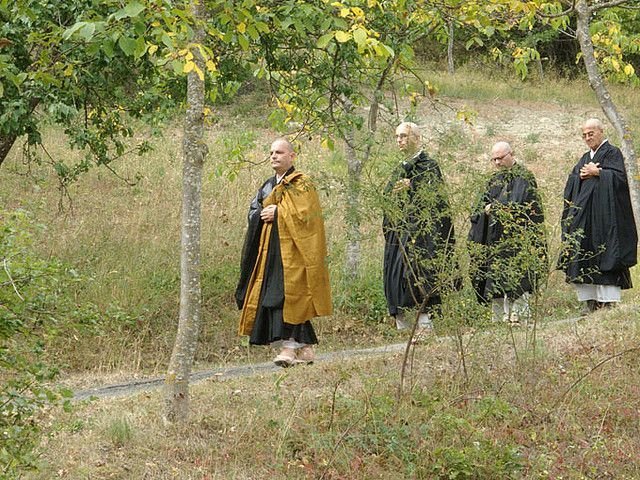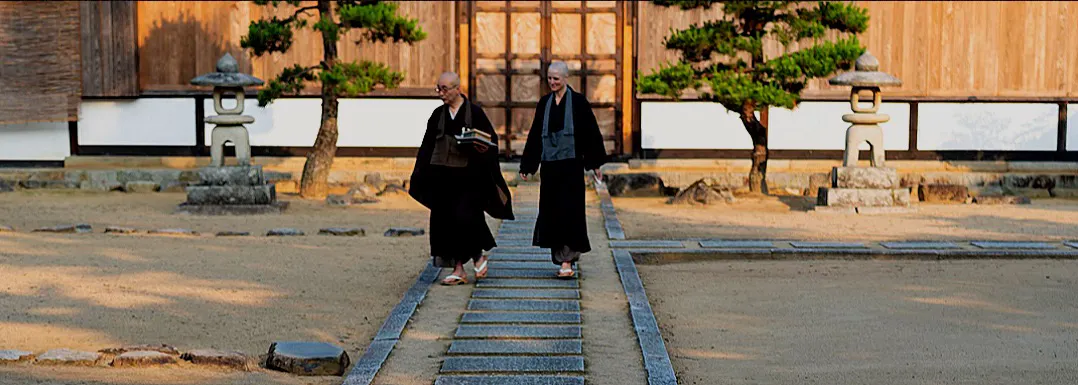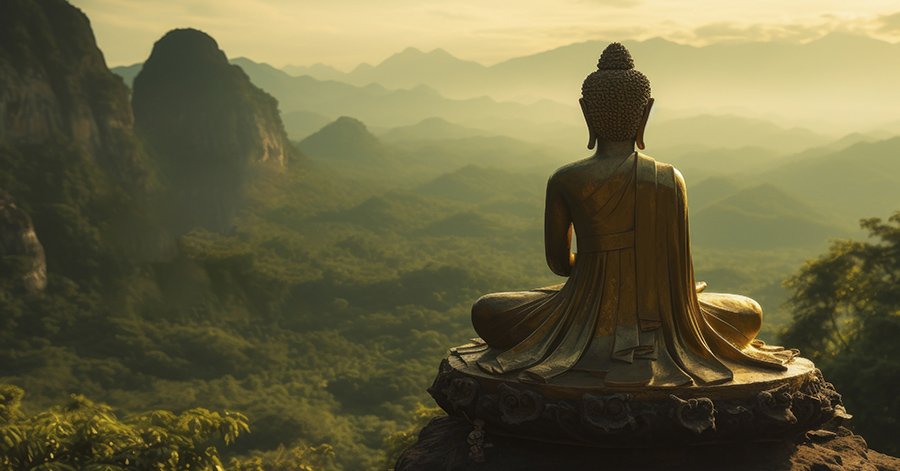How Seniority Shapes Lay and Monastic Buddhist Life
BEZA’s system of seniority is modelled after monastic orders. One of the things that you may notice when you visit a Buddhist monastery is that the monks and nuns sit, eat, walk, and pay respect to each other in a certain order. This order is based on the principle of seniority, which is determined by the date of ordination, not by age, education, or social status. Whoever is ordained earlier is considered senior, and whoever is ordained later is considered junior.
Why do the monastics follow this order and what are the benefits and challenges? How does it affect their roles and responsibilities within the community? Here are some observations on seniority and how it fosters harmony, respect, and learning among the dharma practitioners: lay Buddhists and ordained monastics.

“Ordo” and “Ordinatio”
A synonym for monastics is “The Order”. “Ordination” and “order” share a common origin in the Latin word “ordinatio,” which means “arrangement” or “ordering.” Another Latin word called “ordo” refers to rank and order. “Ordination” refers to the act of being formally admitted to a religious order, and why we use “order” to refer to the group of people who belong to that religious order. When we talk about “The Order” it means that seniority takes on a literal meaning.
Sitting and Eating
When monastics gather for a meeting, a ceremony, or a meal, they sit according to their seniority. The most senior monastic sits at the head of the line, and the most junior monastic sits at the end of the line. This order is maintained regardless of the number of monastics present or the size of the space. The purpose of this arrangement is to avoid confusion and conflict over who should sit where, and to show respect to the elders.
The same order is followed when the monastics receive food. The most senior monastic gets the food first, and the most junior monastic gets the food last. This ensures that everyone gets a fair share of the food, and that no one is left out or discriminated against. The senior monastics also have the option to share their food with the junior monastics, or to give up their food for the sake of others. This cultivates generosity and compassion among the monastics.
Paying Respect
Paying respect is a way of acknowledging the presence and the wisdom of another monastic, and of expressing gratitude and humility. It is done by bowing with the palms together at the chest level, or by prostrating with the forehead touching the ground.
The junior monastics pay respect to the senior monastics, but not vice versa. This is because the senior monastics are seen as the teachers and the guides of the junior monastics, and as the ones who have more experience and knowledge in the practice. The junior monastics also pay respect to the senior monastics when they receive teachings, advice, or instructions from them.
Roles and Responsibilities
Seniority also determines the roles and responsibilities that the monastics take on within the community. Often, the senior monastics teach the Dharma, the monastic discipline, and meditation techniques to the junior monastics. They also answer their questions, correct their mistakes, and inspire them to practice diligently. Most importantly, they become “good quality supportive friends” to the other monastics both senior and junior. The word Theravāda means “The Teaching of the Elders”. Theravāda refers to the teachings of the Buddha, his disciples and also the ancient teachers who helped shape, protect and maintain the lineage through texts and practices..
The senior monastics also take on leadership roles, such as leading the groups, the ceremonies, and the rituals of the community. They are the ones who make the decisions and the rules for the benefit of all. They also take care of the facilities, the schedules, and the events of the monastery, with the help of the lay supporters.
The junior monastics, especially the novice monks, on the other hand, take on supportive roles, such as cleaning, gardening, and serving the senior monastics. They also follow the instructions and the rules of the senior monastics, and learn from their example. In this way, everyone is eventually senior to someone else, except the last ordained monk. Being junior is also a way for humility to arise.
The Importance of Flexibility
While seniority is rigid in terms of who pays respect to who, how to line up and when to get food, it is not a rigid or absolute rule in other areas, and it does not imply superiority or inferiority. It merely means one is older and ordained early. Other areas are flexible and relative and depend on the context and situation. Sometimes, the junior monastics may have more skills or knowledge than the senior monastics, and they may be able to teach or lead them in certain areas. Sometimes, the senior monastics may make mistakes or act unskillfully, and they may need to be corrected or advised by the junior monastics. Sometimes, the monastics may put aside the order of seniority, and treat each other as equals or friends.
Even though respect runs deep for senior monks. That does not mean they are invincible to useful and constructive criticism. The most important thing is not the order of seniority, but the quality of the mind. The monastics should cultivate a mind that is humble, respectful, generous, compassionate, and wise, and that is free from pride, arrogance, envy, jealousy, and ignorance. This is the true spirit of seniority, and harmony plays a central part in gluing together the monastic life.

Seniority in Zen Monasteries
Seniority fosters a clear structure, encourages respect and guidance, and facilitates learning. It helps maintain order, promotes harmony, and allows for the sharing of wisdom and experience. Essentially, seniority helps both the individual and the monastic community – the sangha, thrive. Here’s a more detailed look at the benefits:
Clear Structure and Order: Seniority creates a hierarchy based on experience, which can help maintain order and efficiency within the monastery.
Respect and Guidance: Seniors are often seen as having greater wisdom and experience, leading to a natural respect for their guidance and advice, particularly from younger monks.
Learning and Skill Development: Newer monks can learn from the examples, knowledge, and skills of their more senior colleagues, fostering a culture of continuous learning.
Community Engagement and Harmony: Accepting seniority and one’s place in the community can lead to greater engagement and a stronger sense of belonging, contributing to overall harmony.
Guidance and Support: Seniors can provide guidance and support to newer monks, helping them navigate the challenges and responsibilities of monastic life.
Sharing Wisdom and Experience: Senior monks can share their experiences and insights, helping to guide younger monks on their path to enlightenment.
Model of Practice: Seniors serve as role models for younger monks, demonstrating how to live a dedicated and meaningful life in the monastery.
Dedication and Commitment: The seniority system encourages a sense of dedication and commitment to the monastery and the Buddhist path.
Supportive Sangha: Being part of a Sangha, or monastic community, provides a supportive environment for learning and growth, with both seniors and juniors learning from each other.
Seniority for Dharma Practitioners in BEZA
While BEZA in its current form is not a monastery, nor do we have a training center yet, we do recognize the value of seniority. Considering all the values articulated above within our unique context, BEZA has created a ladder of seniority as a means by which ‘seniors’ can develop and mature within their own lives, and then support ‘juniors’. BEZA’s mission is to ‘train the trainers’ where the teacher (or medicine gatekeeper) in each of us has an opportunity to dispense wisdom. For this to happen a wholesome learning environment must be established – one where everyone is a humble student and a wise keeper of wisdom. We are fostering an environment of collaboration, curiosity, harmony and humility. Being able to identify who may be in need of support and from whom support could be received provides open and conducive access to each other’s experience and inherent heart-mind intelligence.

BEZA’s Seniority Matrix
BEZA seniority is best appreciated for its holistic intention which is the creation of an harmonious and curious training environment. The circle of wisdom and scale of experience is safely guarded and shared appropriately and generously. We are a sangha where the initiated are identifiable – a sanctuary where curious adults engaged in rites-of-passage can respectfully engage with initiated Elders. Student experience is identifiable by their training bibs. Jukai Students wear a Rakusu symbolic of the Buddha’s robes and vows. Soon youth will join our ranks, making these distinctions even more necessary.
While your first date of entry plays a significant role, we consider several additional factors to rank seniority:
- The number of Elemental Modules completed including level of attendance and participation
- Active presence in Zazen and Circle of Connection (Council) sessions
- Attending various non-modular BEZA offerings
- Scale of participation as an Apprentice or Student
- Service to the sangha in various forms e.g. Council of Elders, volunteering skills etc..
- Engaging in specialized trainings e.g. Divination Training, Precept Training
- Interactions with Nangaku and co-facilitators as well as your own realization and embodiment of the Middle Way
At the end of every month, based on the level of your engagement, realization and embodied wisdom, and your capacity to be of service to others within the sangha, we update a weighted matrix composed of the factors described above. As such, Students and Apprentices order themselves in seniority, not in competition or in comparison with each other but as an indication of applied effort, training, modeling, and their availability to guide and support others. If you want to know more about why any sangha member is your senior, engage them in a conversation. Instead of comparing yourself to them and becoming embroiled in the resulting judgments, ask them about the effort they put in, how they value and apply the teachings in their lives, or how they have become more true to themselves and others.
The Truth will always remain in the center. Those closest and most aligned with expressions of truth emanating from the central source of all wisdom become Gatekeepers to that source. They willingly carry the profound responsibility that comes along with their sovereignty which includes, but is not limited to, maintaining the lineage and rites-of-passage pathways verified by those who have gone before. This sacred tending to the ‘road-less travelled’ — a mirrored and modelled map of the Way – requires polishing, updating, and constant renewal. Wherever you find yourself in the matrix of seniority in BEZA, be available with a beginner’s mind, for your own polishing, and the polishing of and by those ahead and after you.
Let us all lovingly discuss, debate, heal and learn from the medicine and dharma inherent in all beings. Let’s claim the responsibility of our sovereignty, and support the revelation of life’s generous gift in each other’s arising and becoming.
Long life, honey in the heart, no evil, 13 thank you’s – a Mayan blessing,
Ekan Nangaku (Founder, Director)
Born as the Earth Zen Academy (BEZA)
Non-profit: NPC# K2024636180
